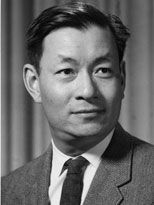Theodore H.H. Pian, who taught in MIT's Department of Aeronautics and Astronautics for more than 40 years and was a pioneer in the stress analysis of materials in aircraft and other stuctures, died on June 20 in Cambridge after a long illness. He was 90.
"To me he exemplified a professor's professor," said James Mar, professor emeritus of aeronautics and astronautics. "He counseled students, he did research that contributed to the theoretical underpinnings for the massive computer programs that are routinely used for structural analysis, he created subjects for undergraduates and graduate students, he was respected by his peers and his deportment was always self-effacing."
Pian was born in Shanghai, China in 1919, and earned a bachelor's degree in engineering from Tsing Hua University in Beijing. After working in the Chinese aircraft industry in the early years of World War II, he moved to the United States in 1943, and earned an SM from MIT's AeroAstro department in 1944 and a ScD in 1948.
Pian quickly progressed at MIT from AeroAstro teaching assistant and research associate to become a full professor of aeronautics and astronautics in 1966. He also gave lectures at 46 universities in the United States and at 55 universities in China, Japan, India, Israel, Germany, the United Kingdom, Canada, and other countries. He retired in 1990.
Always interested in foreign aerospace industry developments and his foreign students at MIT, Pian was also a visiting professor at 10 universities overseas during his career. He was an honorary professor at several leading engineering schools and aeronautical institutes in China.
"Ted Pian was a pioneer in the field of computational methods for structural analysis," said Paul Lagace, professor of aeronautics and astronautics, who was Pian's student before becoming one of his colleagues in the department. "His work helped lay the foundations on which many of today's operational techniques are built. A number of his thesis students who worked directly with him on this development work are key contributors to this field throughout the world today."
Pian wrote more than 200 professional papers and wrote or edited several books in the field of finite element method, a problem-solving technique that, among other things, allows engineers to create simulations that show in great detail where a structure might bend or twist. He pioneered analytical techniques that are used for many types of mechanical calculation, such as deformation, stresses and strains, and fracture in aircraft and other mechanical structures. These methods are now used in the design, evaluation, and testing of metals and other materials to predict accurately their strength and performance. The applications of these methods range from bridges and large aircraft to precision-engineered optical, mechanical and electronic equipment.






